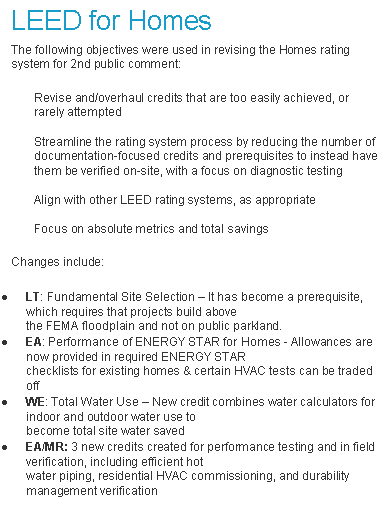It is important that all residential stakeholders comment on the proposed changes to the LEED for Homes rating system. This is your chance to shape the LEED rating system, which is traditionally voted on by a predominantly commercial group. needs you to give feedback and help USGBC balance the need for progress with the realities of implementation to keep this a relevant rating system. These changes are currently slated to take effect in the Fall of 2012. has highlighted specific issues that need your input below:

What version of Energy Star should be used?
Energy Star Version 3 (ESV3) is currently proposed as a perquisite in the LEED 2012 rating system. is concerned that Energy Star Version 3 will cost projects roughly $7,000 more to implement and will not be cost effective. recommends that LEED 2012 use the HERS score as an alternative compliance path for the performance path in EA prerequisites, and reward extra points to those pursing ESV3. Energy Star Version 2 will still be the standard until LEED 2012 goes into full effect, despite Energy Star changes on 1/1/12.
What about LEED for existing homes?
The requirements for ESV3 effectively eliminate any existing home gut rehab projects from obtaining Energy Star certification. If LEED 2012 requires ESV3, then no existing homes will be eligible for LEED certification.
We Need Your Support
encourages all who have interest in residential Green Building to comment on these changes by praising valid changes but also giving constructive criticism to measures that are not feasible in the market. USGBC will take into account strong, defensible, constructive comments that are reinforced with suggestions on exactly how the LEED Rating System should develop.
Below are several links to websites with details on the proposed rating system. We encourage you to review a summary of or the complete details for LEED for Homes 2012 changes. There is a 2012 LEED Webcast to get more information and have your questions answered by USGBC staff. After learning about all the proposed changes, please comment on each credit that is of concern to you.
Update Sept 10th. Other issues included:
1. General
Remove commercial structure and language. Align more closely with familiar LH 2008 structure and language.
Justification: additional complexity will result in a major loss of support infrastructure, and established project teams.
2. LT 5-9
Substantially reduce total number of LT points (i.e., reduce bias towards urban projects; enable more points for non-urban projects)
Justification:80% of new homes are built in non-urban areas. Only 1/3 of completed LH 2008 projects achieved any density credits.
3. EA p1 (EA c1)
Energy performance level should be substantially relaxed for entry level projects (especially market-rate average and large sized homes). Special consideration is needed to address the extremely weak participation (so far) from market rate housing.
Justification:Substantial growth in program will only be achieved if the entry level is defined at a performance level that the market-rate projects consider viable (i.e., cost effective).
4. EA p1: ESH v3
For Prereq, roughly align with ESH v3 only in terms of HERS performance level (i.e. exclude checklists). IMPORTANT: Make this both a prereq AND worth approx 10 EA points. (Note ESH v3 performance levels are not that different from energy performance levels of LH 2008 certified homes.)
Justification:Substantial parts of country will not be able to achieve ESH v3 requirements, partly due to complete void of trained HVAC infrastructure.
5. EA c1: LEED Index (MMBtu)
This proposed energy metric is confusing, complex, unproven, and not implementable (no standards and/or guidelines exist).
Justification:The market has not tolerance for additional complexity. Recent changes in Codes and ESH have overwhelmed the marketplace. Further, it is unprecedented for USGBC to create new national standards, rather than to adopt industry-developed/proven standards.
6. WE c1 (WE c2, WE c3)
Align WE performance and prescriptive path (same # of points in each pathway) – both indoor and outdoor.
Justification:The Prescriptive pathway provides a vital educational component to the LH Rating System – for new green residential projects. These projects are typically unfamiliar with green strategies and upgrade measures. They need to be explicitly in the LHRS.
Public Comment will close on September 14th 2011.

LEED 2012 Homes Webcast Register for the LEED 2012 2nd Public Comment Introduction Webcasts. Free for members!
LEED 2012 Homes Rating System Drafts
Clean Version
Redline Revision Example Version
Summary of Changes
1st PC to 2nd PC
2008 to LEED 2012 2nd PC
LEED 2012 Scorecards
Homes
Homes Mid-Rise
Public Comment
Submit comments on any of the LEED 2012 2nd Public Comment Drafts
